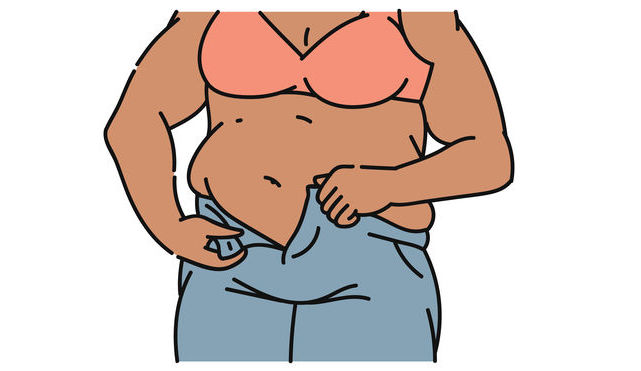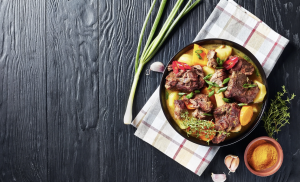After months of working from home and leading a sedentary lifestyle, some of us may be emerging from the lockdown considerably “thicker” around the waist than when it began. This expert shares simple tips to help get your waist ratio back to pre-lockdown levels.
I’m not going to lie; loose clothing and elasticated waistbands are the champions of this lockdown for some of us. But, now that it looks like “outside” is gradually opening up again, perhaps it’s time to banish our comfort clothes to the back of the wardrobe and start to renew our commitment to healthy living.
No matter how much you weigh, feeling healthy is the best feeling. However, for some of us, while life was on pause, our motivation to eat healthily and keep our bodies moving, slowed too, and nowhere does it show more, than our waistlines. This is cause for concern because compared to fat around the hips, fat around the waist is more metabolically active, and is closely related to insulin resistance and seems to be more strongly associated with the risk of heart disease, stroke and diabetes. All of these are health issues that affect Black people disproportionately.
Visceral fat, as it is called, is normally the result of a number of different factors, which include eating too much sugary, starchy food, drinking too much alcohol (particularly beer), not doing enough exercise, feeling stressed and sleeping badly, and, of course, genetics.
“… fat around the waist is more metabolically active, and is closely related to insulin resistance and seems to be more strongly associated with the risk of heart disease, stroke and diabetes.”
Some people when they put on weight, immediately put it on around the gut. The good news is that studies show visceral fat responds well to weight-loss regimes and exercise.
There’s a simple trick to test whether you are carrying too much weight around the middle, and all you need is a piece of string.
Start by cutting a piece of string to make it as tall as you are. Then fold that piece of string in half and try to wrap it around your middle. See if you can make the two ends meet. If you struggle to do this, it suggests that you are carrying too much weight around your middle, and therefore, your visceral fat level is probably too high.
If you are worried about your health and would like to take some steps to reduce your waist ratio, TV presenter, doctor and author of The Fast 800, Dr Michael Mosley has shared some simple changes you can make to rejuvenate your lifestyle.

Resetting our sugar addiction
Have you ever wondered why the more sweet treats we eat, it becomes harder and harder to resist a bite (or two, or three?).
Appetite, it turns out, is much more a matter of how our bodies respond to insulin, than of how physically full our stomachs happen to be. After a meal, the body keeps its blood-sugar levels within a safe range by releasing insulin. This, in turn, allows glucose to enter muscle cells for burning, and fat cells for storage. Insulin also triggers your neurons to send a “don’t eat” message to your appetite-centres.
This works well enough when we leave a good space of time between meals, and eat low-sugar, high-fibre foods, as our ancestors did for millions of years. In the sugar-saturated modern world, though, the system breaks down. Dosed with frequent glucose-spikes, our insulin receptors grow insensitive. Even though we have taken in more than enough energy, our sense of fullness is blunted: We feel a continuing urge to eat more.
Effective weight loss depends on putting a brake on the vicious cycle of insulin resistance. By cutting out high-sugar foods, changing our eating patterns and exercising, we give our cells a chance to recover, and to regain their insulin sensitivity, in the brain as well as in the muscles. Before long, it becomes easier to feel fuller for longer.
- Choose whole grains, such as brown rice, quinoa, millet and spelt, rather than processed carbs such as bread and white rice. Pulses are another excellent source of complex carbohydrate
- For the first meal of the day, eat a portion of protein-rich food. Studies have shown that this makes sugary food less tempting later on in the day
- Snack on low-sugar fruits. Raspberries, strawberries, blackberries, apples and pears are all relatively low in sugar, and can be eaten safely in moderation. Remember though, fruit served at room temperature tastes much sweeter – so don’t eat it straight from the fridge!

Intermittent fasting
Short-term fasting can lead to several changes in the body that make fat burning easier. This includes reduced insulin, increased growth hormone, and a small boost in metabolism.
According to a 2014 review of the scientific literature, intermittent fasting can cause weight loss of 3-8% over 3-24 weeks. Not only this – but people lost 4-7% of their waist circumference as well – indicating a large loss of the harmful belly fat in the abdominal cavity, strongly linked to chronic disease.
The optimum diet for a healthy lifestyle is the Mediterranean diet. Those following this type of diet are 30% less likely to die from a heart attack or stroke and cut their risk of developing type 2 diabetes by 50%. A Mediterranean diet includes tomatoes, fresh fish, olive oil and plenty of fresh, healthy vegetables. You can also enjoy tinned ingredients like capers, anchovies, pickled cabbage, cannelloni beans, sun dried tomatoes and peppers in olive oil, tinned tuna, sardines, pesto etc – all of these ingredients are packed full of nutrients and fall into the Mediterranean diet category. Also, don’t discount frozen foods. Don’t be afraid to swap fresh for frozen in these times!
“People go on a treadmill for 30 minutes, burn around 120 calories, then lie around and reward themselves with a muffin.”
HIIT is the answer
Short HIIT exercises over low or medium intensity movement beats jogging. Also, the biggest problem with exercise is compensatory eating and relaxing afterwards. People go on a treadmill for 30 minutes, burn around 120 calories, then lie around and reward themselves with a muffin. The theory with HIIT seems to be that it suppresses your appetite, so that this is less likely to happen.
Researchers have also learned that unlike normal-intensity exercise, HIIT directly targets visceral fat, burning away the fatty deposits that can lead to insulin resistance and type 2 diabetes.
Get out in your garden if you have one for some fresh air – if not, clear a space in your lounge, open the windows for some short bursts of daily HIIT. Just 20 minutes a day of activity that makes you out of breath will help you maintain a degree of fitness. You can use household objects like heavy tins and sealed bags of sugar or flour for hand weights.












